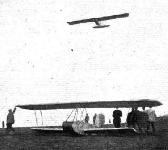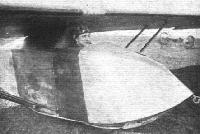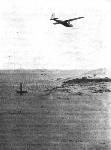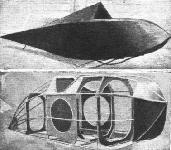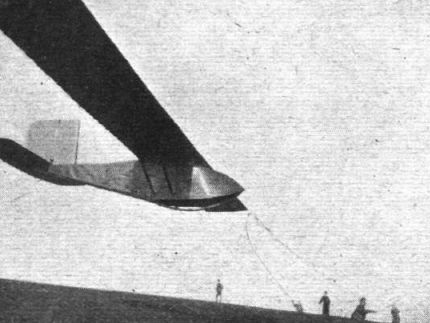
Варианты
- Darmstadt - D-04 - D-07 - 1922 - Германия
- Dessau - Der Dessauer - 1923 - Германия
M.Simons The World's Vintage Sailplanes 1908-45
THE MARGARETE
In 1923, along with the Konsul, the Darmstadt Akaflieg brought out the first practical, dual-controlled training two-seat sailplane. Resplendent in doped fabric and clear varnish, the Margarete was named after Margarete von Loessl, widow of Eugen von Loessl who had been killed at the first Rhoen meeting in 1920. The wing planform was at first a simple rectangle with nearly square tips. The aerofoil was Goettingen 533. Two spars took the bending and twisting loads and plywood covered the leading edge. The ailerons, as on the Konsul, were of vast area, triangular in plan and hinged diagonally. The fuselage was plywood covered and of a neat, semi-streamlined form. The wing was in two sections, joined on the centre line and bolted to the fuselage frames at the rear spar position only. Large 'V' struts braced spars to the fuselage. The pilots sat in tandem, the rear seat being well back beneath the wing. At the root, a strong central member carried loads from the front spar back to the pylon aft of the rear cockpit, so the second pilot’s view was not obscured by a forest of struts. The gap where the wings joined at the centre was covered by a laced fabric fairing. The pilots had no windscreens. The tail unit was large and angular.
Early flights proved that the elevator and ailerons, cable driven, were inadequate in spite of their size. Modifications were made, the ailerons were redesigned to a form with narrower chord and less area. This would reduce the control forces needed. There were no further difficulties and the Margarete became very popular. The two seater attended every important gliding meeting for four years, carried many passengers, and introduced many young pilots to soaring flight. In August 1925 at the Wasserkuppe. Hesselbach soared with a passenger for just over three hours and later, on the Crimean expedition, nearly doubled this with a remarkable record flight of 5 hours 52 minutes. By 1928 the Margarete had outlived all the gliders, including the Konsul, that had flown at the 1923 meeting. Probably it had, like all two seaters ever since, been overworked and abused. Standards of inspection and maintenance were somewhat lower than they were later to become and four years’ flying had taken their toll.
The end came in a crash caused by a broken aileron cable, fortunately without serious consequences for the pilot, Bubi Nehring, at the Rhoen in 1928.
Technical data:
Margarete: Span, 15.30 m. Wing area, 25 sq m. Aspect ratio, 9.36 Empty weight, 180 kg. Flying weight. 320 kg. Wing loading, 12.8 kg/sq m. Aerofoil, Goettingen 533.
Описание:
- M.Simons The World's Vintage Sailplanes 1908-45
- Flight, September 1922
Фотографии
-
Flight 1922-10 / Flight
THE DARMSTADT MONOPLANE GLIDER "EDITH." In the illustration the machine is just getting away. Note the tow rope dropping from its quick-release in the nose of the fuselage.
-
Flight 1922-09 / Flight
The Darmstadt monoplane, piloted by Bottsch, flying over the Dresden biplane.
Другие самолёты на фотографии: Dresden D-B01 Stehaufchen - Германия - 1921
-
Flight 1922-10 / Flight
The Darmstadt monoplane, of which scale drawings were published in our issue of September 21, 1921. Herr Bottsch just managed to land the machine before striking the trees, but damaged the fuselage in doing so.
-
Flight 1922-10 / Flight
Herr Bottsch in the cockpit of the Darmstadt machine. Note the quick-release in the nose of the fuselage. This machine has made flights of long duration, one being of 1 1/2 hours.
-
Flight 1924-08 / Flight
Two-seater Gliders: Front portion of the "Margarete" (No. 35), showing two cockpits and peculiar mounting of the monoplane wing.
-
GL / M.Simons - The World's Vintage Sailplanes 1908-45 /Kookaburra/
The Margarete preparing to launch. The name, Margarete, was inscribed on the nose in joined script.
-
Flight 1930-03 / Flight
THE MARGARETE: A glider of the intermediate type being flown by the flying section of the Technical High School at Darmstadt. They gained the first prize for the two-seater class in the Rhon Gliding Competition.
-
Flight 1925-05 / Flight
A two-seater glider at Rossitten: The Academic Flying Group, Darmstadt's "Margarete," in flight over the Kurischen-Haff. Note the kind of country over which the machines fly.
-
Flight 1924-08 / Flight
From the Rhon Meeting: No. 46 ("Moritz") and No. 35 ("Margarete") in the air together. On this occasion "Margarete" is not carrying a passenger.
Другие самолёты на фотографии: Hannover H.1 Vampyr / H.2 Greif / Strolch - Германия - 1921
-
Flight 1922-09 / Flight
TWO DARMSTADT FUSELAGES: Top, the body of the Type 4 monoplane; bottom, the nacelle of the biplane.
-
Flight 1922-09 / Flight
THE THREE DARMSTADT MACHINES: General arrangement drawings.
-
Flight 1922-10 / Flight
Darmstadt Monoplane 1921
-
GL / M.Simons - The World's Vintage Sailplanes 1908-45 /Kookaburra/
Darmstadt Margarete
- Фотографии

